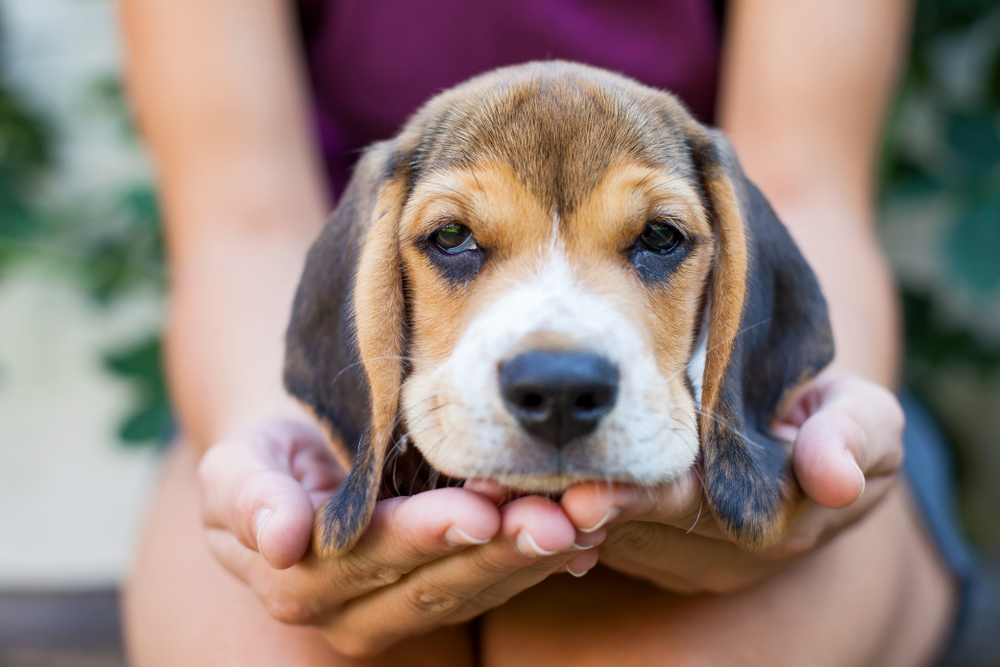The dog brain is very different from that of wild dogs, so that in some ways puppies are born ready to fit into the human world. But the puppy brain still has a lot of developing to do after birth, and understanding that process is important to raising confident, well-adjusted dogs.
It’s now generally believed that dogs essentially domesticated themselves when human civilization developed to the point that it could be a source of food. “Humans created a new environmental niche,” says Jessica Hekman, DVM, Ph.D. “There was an opportunity for this animal to start living closer to humans and taking advantage of our garbage dumps and extra food.” It’s easier to make use of this opportunity, though, if you don’t run and hide whenever people come near. “It became adaptive for them to be less afraid,” she says.
Less fearful animals got more food and left more offspring, who were also less fearful. The result was a domesticated animal with fundamental differences in brain and body. Hekman’s research looks at the functioning of the parts of the brain that control cortisol levels, which are one measure of stress. She says studies comparing stress reactions in domesticated animals and their wild counterparts suggest that cortisol levels don’t increase as much in domesticated animals and decrease more quickly from peak levels. At a physical level, the stress system actually functions differently so that dogs are predisposed to be more tolerant of stressors like human activity.
Survival factors
Still, to survive, any animal needs to know what and what not to fear. When puppies first begin exploring their environment when they are about three weeks old, their brains start laying down important associations that essentially teach them that home is a good place to be. “Their brain makes the assumption that this space right around me is a safe space and this is what’s going to be normal for me in my environment,” Hekman says. This assumption is so strong that puppies actually don’t show a fear response at that age. “You can show them something totally new that they’ve never seen before and they don’t care. They’re not afraid at all.”
One of Hekman’s colleagues, Kathryn Lord, researches early development of dogs and wolves. The timing of this process seems to be another thing that has changed in the course of domestication. Puppies already have their eyes and ears open when they begin to explore, in contrast to wolves, who begin leaving the den when they’re still deaf and blind. Lord’s work suggests that this is one reason dogs end up less wary than wolves: their brains are making a “safe and normal” association to a wider range of experiences -sights and sounds instead of just smells-during that crucial period.
Timeline
However, the period is still limited. Sometime between 5 and 8 weeks in dogs, the fear response kicks in. For the puppy, that means new things become scary; that’s an important survival response for a youngster increasingly able to wander independently. For the prospective puppy owner, that means a couple of things: first, make sure the breeder is working with the puppy before you take him home.
“The period when puppies are with the breeder is the most important time for socialization,” says Hekman. “You get enormous bang for your buck there.” This period is when it’s easiest to get puppies to be accepting of all the crazy sights, sounds, feelings, and activities of the human world. At this point, all that needs to happen is for a puppy to be exposed to those things.
Second, it’s crucial to understand is that once the fear response in the brain comes online, socialization can no longer be mere exposure; it needs to be a more thoughtful and active process. Although the puppy brain is more malleable than it will be at maturity, it’s no longer recording everything it experiences as safe and normal.
Make experiences positive
“Socialization isn’t just ‘expose my dog to things and hope he gets used to them,’” says Erica Feuerbacher, Ph.D., assistant professor at Virginia Tech College of Agriculture and Life Sciences. “You need to make sure they have good experiences.”
At this age you can no longer assume that a puppy will get used to, say, noisy trucks, just by being exposed to them enough times. You need to actively put positive associations in place; for instance, noisy trucks driving by means that a handful of treats appears.
Intensive socialization like this is most important and effective up to about four months of age, but that’s not the end of it. Brain development is never really over: everything learned changes the brain, and dogs can learn new things for their whole lives, for good or ill. Good behaviors and social skills must be maintained.
“Dogs still need to be trained and reinforced for doing what owners want them to do,” Dr. Feuerbacher says. “It’s an ongoing process.”
While even well-socialized dogs can sometimes learn new fears later in life, those fears are easier to deal with if dogs have a solid foundation of positive associations built up in puppyhood. “It kind of inoculates them if they have lots of positive early experiences,” says Dr. Feuerbacher. “You get a dog that bounces back faster if he does have a bad experience later on.”
This article was reviewed/edited by board-certified veterinary behaviorist Dr. Kenneth Martin and/or veterinary technician specialist in behavior Debbie Martin, LVT.








